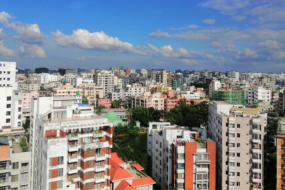The recent hikes in interest rates carried out by the Reserve Bank of India amounting to cumulative increase of 190 bps by September 2022, have adversely impacted the home purchase affordability , with pan-India markets seeing a decline in the affordability index in the third quarter of 2022 , in turn adversely impacting the home buying decisions .
According to Knight Frank India Affordability Index study for Q3 2022 that all markets have seen a decline in affordability.The study notes that the 0.95% cumulative increase in median home loan rate will impact affordability of homebuyers and thus their purchase decisions as well. As per the nine-month assessment (9M CY 2022) of the affordability index, Ahmedabad continued to remain the most affordable housing market amongst the top eight cities, with a ratio of 22% followed by Pune at 26% and Chennai at 27%.
Knight Frank’s proprietary Affordability Index, which tracks the EMI (Equated Monthly Instalment) to income ratio for an average household, witnessed steady improvement from 2010 to 2021 across the eight leading cities of India especially during the pandemic when the RBI cut repo rates to decadal lows. As the repo rates saw a cumulative hike of 50 bps by the third quarter, home purchase affordability decreased on an average by 2% across markets while the EMI load went up by 7.4%.
EMI to Loan Value Ratio Change
| 2021 | Q3 2022 | Change | |
| Loan Value | 10,00,000 | 10,00,000 | |
| Rate of interest %pa | 7.30% | 8.25% | 0.95% |
| Tenure in years | 20 | 20 | |
| EMI | 7,934 | 8,521 | 7.4% |
Affordability Index of Leading 8 cities of India
| City | EMI to Income Ratio | |||||
| 2010 | 2014 | 2019 | 2020 | 2021 | Q3 2022 | |
| Mumbai | 93% | 97% | 66% | 53% | 53% | 57% |
| Hyderabad | 53% | 42% | 33% | 28% | 29% | 31% |
| NCR | 48% | 57% | 34% | 26% | 28% | 30% |
| Bengaluru | 39% | 52% | 32% | 24% | 26% | 28% |
| Kolkata | 51% | 48% | 31% | 25% | 25% | 27% |
| Chennai | 47% | 47% | 29% | 29% | 25% | 27% |
| Pune | 45% | 43% | 28% | 25% | 24% | 26% |
| Ahmedabad | 46% | 40% | 25% | 20% | 20% | 22% |
Source: Knight Frank Research
Note: 1. For Q3 2022, Affordability and income levels are calculated keeping all variables constant, except for the interest rate.
Note: 2. City-wide average affordability statistics cannot highlight disparities in housing costs within sub-markets or across the income spectrum
According to Shishir Baijal, Chairman and Managing Director, Knight Frank India , the home affordability, due to the rise in median loan rates got worsened in 2022. After , RBI’s 30 bps increase in repo rates on 30 September, resulting in cumulative hike of 190 bps affordability worsened by 2% points across cities since the rate cycle changed. This will impact affordability of homebuyers and thus their purchase decisions as well. However, with the need for homeownership still being strong, homebuyers will largely make necessary compromises by considering lower priced housing units rather than deferring their purchases as expectations of further price increases will discourage deferment.
CITY WISE UPDATE
Mumbai
The city remains the most expensive residential market in the country. From 97% in 2010, the home purchase affordability index registered a significant improvement to 53% in 2020. Mumbai is the only city that witnessed the affordability index improving at the rate of 4% from 53% in 2021 to 57% in Q3 2022. This still remains very much optimistic in regards to the pre-pandemic levels of 66% in 2019.
Hyderabad
Hyderabad is the second most expensive residential market in the country. From 53% in 2010, the home purchase affordability index improved to 33% in 2019. With the advent of the pandemic in early 2020, the affordability index further improved to 29% in 2021. In Q3 2022, the affordability index of the city currently stands at 31%.
NCR
NCR ranks third in terms of most expensive residential market in the country during Q3 2022. The city’s affordability index has been fluctuating year on year. From 48% in 2010, the home purchase affordability index improved to 34% in 2019. With the advent of the pandemic in early 2020, the affordability index further improved to 26% in 2020 but declined to 28% in 2021. In Q3 2022, the affordability index of the city currently stands at 30%.
Bengaluru
Bengaluru follows NCR in terms of expensive residential markets in the country, ranking 4th expensive city in India. From 39% in 2010, the home purchase affordability index improved to 32% in 2019. With the advent of the pandemic in early 2020, the affordability index further improved to 24% in 2020 and again to 26% in 2021. In Q3 2022, the affordability index of the city currently stands at 28%.
Kolkata
Kolkata ranks fourth most affordable residential market in the country. From 51% in 2010, the home purchase affordability index improved to 31% in 2019. With the advent of the pandemic in early 2020, the affordability index further improved to 25% in 2021. In Q3 2022, the affordability index of the city currently stands at 27%.
Chennai
Chennai remains the third most affordable residential market in the city. From 47% in 2010, the home purchase affordability index improved to 29% in 2019. With the advent of the pandemic in early 2020, the affordability index further improved to 25% in 2021. In Q3 2022, the affordability index of the city currently stands at 27%.
Pune
Pune maintains its stance and remains the second most affordable residential market in the city. From 45% in 2010, the home purchase affordability index improved to 28% in 2019. With the advent of the pandemic in early 2020, the affordability index further improved to25% in 2020 and then to 24% in 2021. In Q3 2022, the affordability index of the city currently stands at 26%.
Ahmedabad
Ahmedabad has consistently been the most affordable city in India since 2019. From 46% in 2010, the home purchase affordability index improved to 25% in 2019. With the advent of the pandemic in early 2020, the affordability index further improved to 20% in 2021. In Q3 2022, the affordability index of the city currently stands at 22%.



